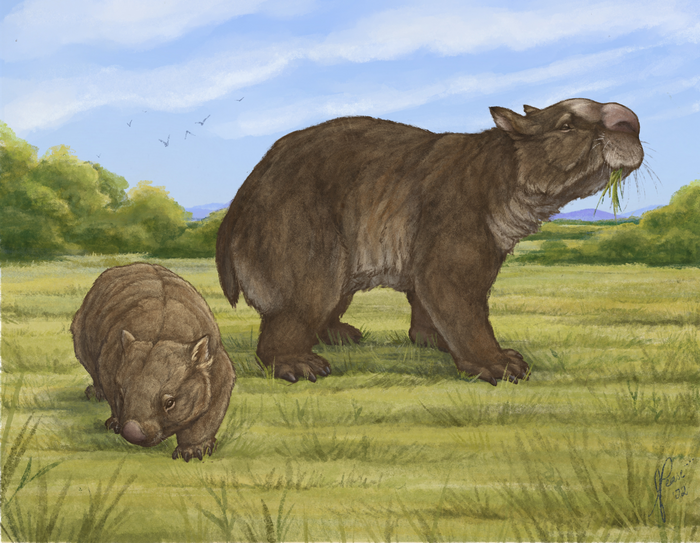
Fossil of sheep-sized giant wombat found in Queensland cave
Wombats are iconic Australian marsupials that move ponderously, have very slow metabolic rates and dig extensive burrow systems. There are three living species in the family Vombatidae, all of which are herbivorous. The evolutionary history of wombats is not very well understood, but their lineage goes back millions of years to the early Miocene, and includes a number of species that were very large. A new fossil skull from one of the rarest of these giant wombats has now been described from a cave in Rockhampton, Queensland.
The complete skull is estimated to be around 80,000 years old and, although it was discovered in 2000, it has been described for the first time by a team of scientists led by Professor Julien Louys from the Australian Research Centre for Human Evolution at Griffith University.
He explains that the skull was from Ramsayia magna, one of three species of giant wombats that scientists are aware of.
“They’re closely related to the modern wombats but they’re much larger than the current species,” Associate Professor Louys said. “[There are] about a dozen specimens across the entirety of the continent of Australia, so it’s incredibly rare.” The team’s analysis of the ancient skull has been published in the scientific journal Papers in Palaeontology.
Confusingly, there is another extinct large marsupial that is far more commonly found in fossil deposits in Australia, and that is known locally as the “giant wombat.” This huge marsupial, named Diprotodon, dates back to the Pleistocene Period in Australia, but is not a true wombat and is not a member of the Vombatidae family.
“Although one of the most charismatic of the giant mammals to go extinct, Diprotodon is commonly referred to as a ‘giant wombat.’ But this is incorrect as Diprotodon belongs to an entirely different family – equivalent to saying a hippo is just a giant pig,” explained Professor Louys.
“There were, however, true giant wombats. These have traditionally been poorly known, but the discovery of the most complete skull of one of these giants, Ramsayia, has provided us with an opportunity to reconstruct what this creature looked like, where and when it lived, and how the evolution of giant wombats took place in Australia.”
The cranium and mandible of the Ramsayia magna fossil was discovered from the rear of the front chamber of Lower Johansons Cave in Rockhampton, in the early 2000s, but it was only through subsequent excavations and analysis by Associate Professor Louys’s team that is was confirmed as belonging to this previously described but very poorly known species.
The paleontologist explained that previous fossil remains consisted mostly of fragments of jaws and teeth, from which very little about these “gentle giants” and their habits could be deduced. However, this new and almost complete specimen gives more information for the scientists to work with.
“We’re able to determine not just what it looked like, but most likely what it ate, and we’ve made some inferences into some of its behavioral adaptations,” said Professor Louys.
The giant wombat was twice the size of modern wombats, approximately the same size as a sheep. It had a rounded skull with sinuses (air spaces) at the back, which is a feature not found in modern wombats. The researchers say that air pockets like this can indicate instances where the skull of a species grows large while the brain stays relatively small. The associated sinuses fill in the space without adding too much extra weight. Alternatively, a large skull with sinuses may increase the surface area for muscle attachment, indicating that the animal had to chew tough food.
The new skull also has an unusual vertical spine of bone protruding from the giant wombat’s nose. Called a “premaxillary spine,” it most likely developed to provide structural support for a large, fleshy nose; not quite a trunk, but certainly a sizeable nasal appendage.
Louys said the Ramsayia skull contrasts remarkably with the modern wombats, which have a much flatter skull. “We think that this giant wombat, with a more domed skull, perhaps wasn’t living in burrows like the modern wombat does.”
The researchers show in their paper that the true giant wombats evolved large body size first, then individually became quite specialized to eat different types of grasses. “Once these giant wombats became giant, then they became even more specialized, focusing on different aspects of the environment, of the grasses that were around in Australia at the time,” Louys said.
“We also dated this species as being about 80,000 years old. This is the first date for this species and is much earlier than human arrival in Australia, although we still don’t know exactly when or why this species became extinct.”
Image Credit: Eleanor Pease
—
By Alison Bosman, Earth.com Staff Writer
Check us out on EarthSnap, a free app brought to you by Eric Ralls and Earth.com.












